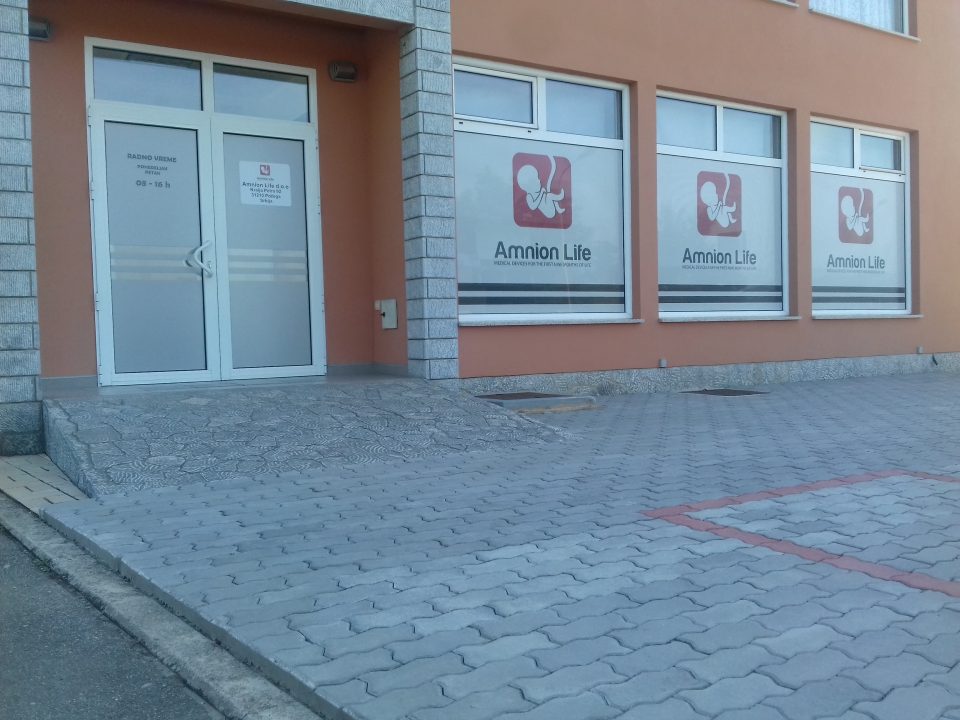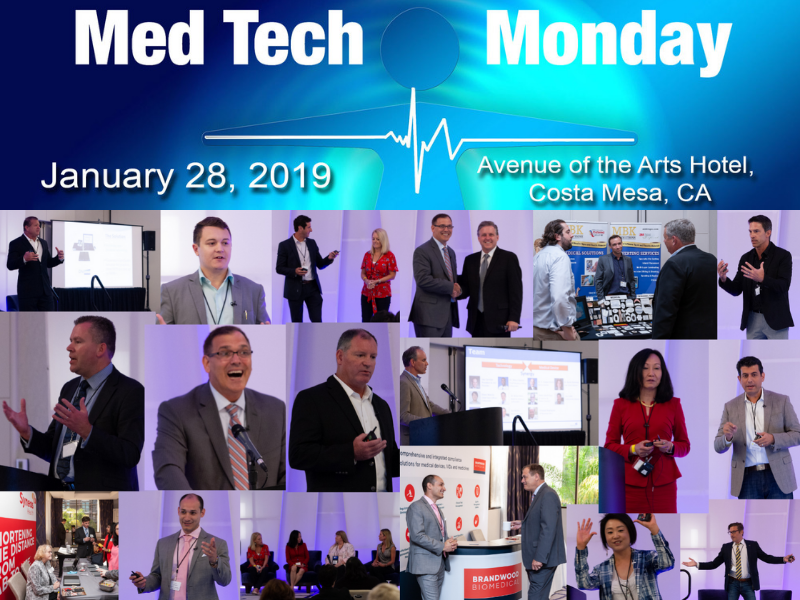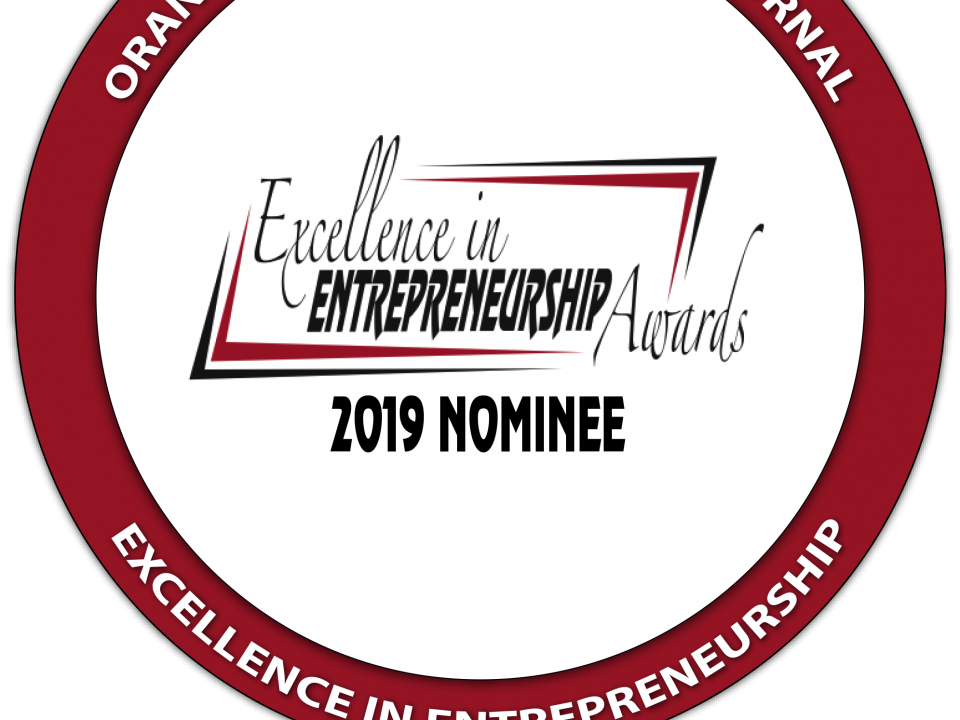
Increasing Survivability and Thrivability for Preterm Infants
Videos
The Problem
15 million infants are born prematurely each year across the globe

More than 400,000 of them in the United States.
- Per CDC, Premature Birth is the #1 cause of death for infants in the U.S.
- Per WHO, it is the leading cause of death for children less than 5 years globally.
- Today, one preemie is born every minute.
- Preterm birth infants can acquire long-term health problems in their NICU stay creating a lifetime of financial and emotional costs.
- Preterm infant body habitus is highly susceptible to heat loss and does not have thermoregulatory mechanism leading to high incidence of hypothermia in this population
- Hypothermia in preterm infants causes a stress response leading to episodes of hyperglycemia followed by hypoglycemia, lactic acidosis, increased oxygen requirements and hypokalemia.
- Cascade of events after hypothermia in preterm infants has been directly linked to sepsis, pulmonary hemorrhage, intracerebral hemorrhage, necrotizing enterocolitis and death.
The Outcomes
Hypothermia is an important cause of death morbidity & mortality in preterm infants

- Per CDC, medical complication after premature Birth is the #1 cause of death for infants in the US.
- Per WHO, medical complications after pretermature birth is the #1 cause of death of children globally less than 5 years of age
- Today, one preemie is born every minute.
- Many survivors have long-term health problems. It is the #1 cause of cerebral palsy in society
- Negative outcomes in the NICU for preterm birth infants create a lifetime of financial and emotional costs.
NICU Level 3 & 4 Preemies are
Subject To:

Leading To:
- Brain Hemorrage
- Necrotizing Enterocolitis
- Respiratory Distress
- Bronchopulmonary Dysplasia
- Periventricular Leukomalacia
- Apnea
- Sepsis
- Meningitis
- Anemia
- Convulsions
- Death
Subject to:
Hypothermia
Leading to:
- Activation of sympathetic nervous system and release of norepinephrine
- Transient hyperglycemia
- Glycolysis (breakdown of sugar)
- Increase oxygen use
- Followed by hypoglycemia
- Lactic acidosis
- Hypokalemia
Resulting in:
- Brain Hemorrhage
- Sepsis Convulsions
- Respiratory Distress
- Anemia
- Periventricular Leukomalacia
- Apnea
- Necrotizing Enterocolitis
- Meningitis
- Bronchopulmonary Dysplasia
- Death
The Solution
Amniobed is inspired by nature

AmnioBed™, the Revolutionary Proprietary MedTech Device
- Amniobed™ Golden Hour – is intended to replace the use of radiant warmer/plastic wrap in the labor and delivery room to allow optimal temperature regulation of the infant and prevent transitional hypothermia (incidence 25%-78% in very preterm and extreme preterm infants) immediately upon birth during resuscitation and umbilical catheter placement.
- Amniobed™ 24Hour is intended to replace convection incubators for use in the NICU for up to 28 days. It is intended to improve temperature regulation, fluid management, skin protection and general comfort for preterm infants thus increasing their rate of weight gain in the NICU while decreasing short term and long term complications arising from hypothermic episodes and insensible water loss.
- Artificial Placenta is a patented extracorporeal membrane oxygenation and nutrition maching intended for infants with under-developed lungs who need oxygen support in the critical setting. It is a novel and patented device that gets connected to infant umbilical vessels immediately upon cutting the cord.
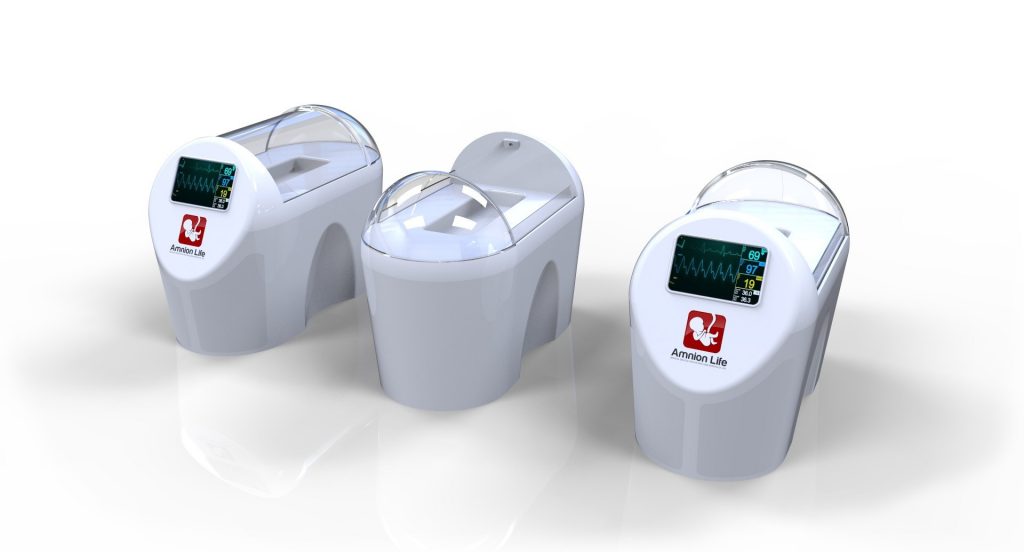
The Company has established a research and development facility with clean-room in Pozega, Serbia. All parts and components for Amniobed Golden Hour were sourced, procured and assembled into a prototype.
The device is a complex system with multiple sub-assemblies, custom designed PCB and HMI/software. Design Control, Quality Management System (QMS) and Risk Management guidelines were adopted and software for the device developed.
The Company goal in 2020 is to complete the Design History File (DHF) for Amniobed Golden Hour, perform pre-clinical verification and usability testing of the device in order to obtain Investigation Device Exemption (IDE) from the FDA. The goal is to be ready for in-human pilot study by the end of 2020.
Amnion Life is engaged with, and represented by, the law firm of Knobbe Martens that specializes in medical device IP. The Company has multiple issued US utility patents directed to its core products, which take into account both defensive and offensive patent strategies for the Company.
Patents
Below are some highlights of the Amnion Life’s patent portfolio:
Amniobed Patent Family
Amnion Life has the following issued patents directed to Amniobed:
- US Patent No. 9,662,257, issued on May 30, 2017
- US Patent No. 10,166,161, issued on January 1, 2019
- China Patent No. 201680064293.7 issued on January 8, 2020
- U.S. Patent No. 11679198 issued on June 20, 2023
Amnion Life has pending foreign patent applications in the following jurisdictions:
- Europe
- Japan
- India
- Australia
- Hong Kong
Amnion Life continues to pursue additional and/or broader claims directed to AmnioBed in continuation patent applications in the US and China.
Artificial Placenta Patent Family
Amnion Life has the following issued US patent directed to Artificial Placenta:
- US Patent No. 10,441,490, issued on October 15, 2019
A corresponding PCT Patent Application No. PCT/US2019/012747 was filed on January 9,2019.
The PCT authorities, in a written report on May 1, 2019, found the claims in the Artificial Placenta PCT patent application to be novel, non-obvious, and having industrialapplicability.
Amnion Life plans to file one or more foreign national phase patent applications based on the PCT application.
Amnion Life continues to pursue additional and/or broader claims directed to Artificial Placenta in continuation patent applications in the US.
Strategic options for the future are being secured with continuation/divisional applications.
For further information, please email: patents@amnion.life
Amnion Life has the following allowed US trademark application for “AMNIOBED”:
- US Trademark Application No. 87/913914
Amnion Life has the following foreign trademark registrations/applications for “AMNIOBED”:
- China
- Europe
- United Kingdom
- India
- Korea
- Japan (pending application)
AmnioBed™ is fluid filled incubator intended to create a warm and safe environment for growth and development of preterm infants.
Five Medical grade water purification filters eliminating heavy metals, contaminants, and microorganisms from the hospital water supply and bringing the water to dialysis grade purification standards.
A medical grade heating system to create on-demand warm water at 98.6F.
Significant safety mechanisms for fluid temperature regulation.
Custom made disposable cartridges filled with concentrated electrolyte and mineral content.
Computer operated dosing pump mixing concentrated electrolyte and mineral solution with purified water.
Capability to adjust synthetic amniotic fluid osmolality from 280mosm/ml to 240 mosm/ml per medical team requirements and infant needs.
Sterile and disposable bath cover and infant harness made of medical grade plastics.
Safety chest and pelvic harness to prevent the infant from submerging into the fluid.
Ergonomically designed infant bed for comfortable positioning of the infant.
Comfortable and natural fluid environment for infant exercising of arms and legs.
Continous filtration of bath fluid through medical grade UV filters.
Fluid clarity sensor to detect stool and automatically flush bath fluid when infant defecates.
Specially designed infant cap with built-in ECG sensors, EEG sensors, Infrared sensor, skin temperature sensor, O2 Saturation sensor and cap opening on the anterior fontanelle for ultrasound probe placement.
Bridge and anchor over the fluid to protect the umbilical catheters from getting submerged.
Audio and Video feed to a smart app on mother's phone for remote visual observation of infant at all times and for remotely speaking to the infant and exposure of the infant to mother's voice.
Amir Fassihi MD Answers: Infant in AmnioBed sits on a donut shaped cushion. The fluid directly below the genitals is constantly monitored for stool content and if stool is detected, the computer system automatically flushes the bath fluid and replaces it with fresh warm synthetic amniotic fluid. The fluid in the bath is also continuously circulated through a UV filter that kills 99% of pathogens on every pass. Infant urine in the bath is not a problem as natural amniotic fluid in mother’s womb is mostly made of fetal urine.
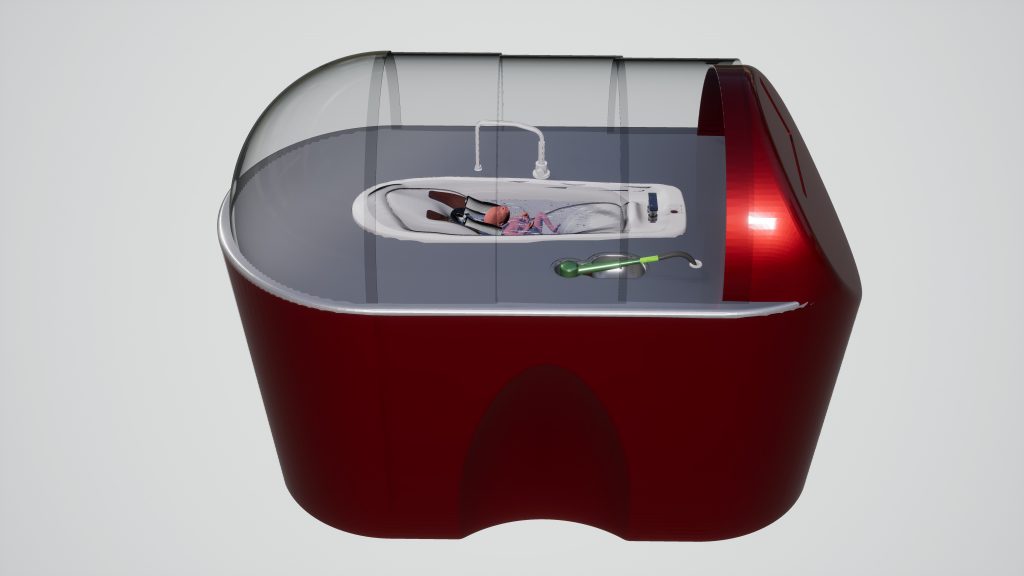 System will be able to flush out the fluid with new fluid via a sensor in the system
System will be able to flush out the fluid with new fluid via a sensor in the system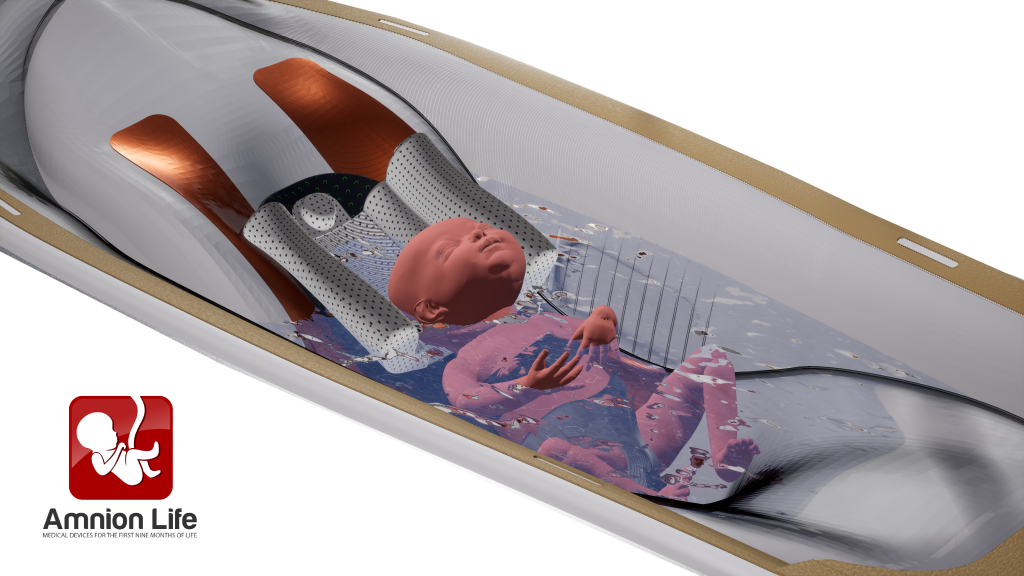 Our patented incubator system – AmnioBed
Our patented incubator system – AmnioBed– when the infant is connected to intravenous lines, an umbilical catheter, an endotracheal tube, has a functioning GI tract and is accessed by medical staff and the family?
Amir Fassihi MD Answers: Thank you for our very important question. We’ve spent 3 years on R&D on this element and safety mechanisms in our patent application are what makes our IP unique in this field and why we think we will be the leaders in next generation of synthetic amniotic fluid incubators for preterm infants.
In AmnioBed, the infant is safely and securely harnessed in the bath on angled seat with head and neck above fluid line at all times. The infant wears a head cover/device which partly helps to reduce heat and water loss from head and neck area, but also has important sensors such skin temperature monitoring and O2 saturation monitoring. It also has a fluid sensor on the chin area which can detect fluid if levels rise above the chin so that it can automatically lower fluid level and inform nursing.
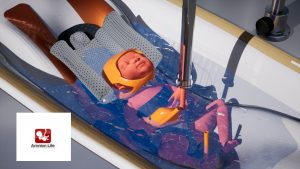 We are working on either placing the ECG leads partly on the head/scalp monitoring device or possibly on the bath itself and pick on signal in the bath. Our concern at this time is the noise level on the signal and we will have to do some testing to see where is the best place to capture ECG signal for monitoring. On the central lines, we are developing an umbilical catheter anchoring system to help maintain umbilical catheters isolated from bath fluid at all time. How it works is that in current practice the umbilical cord is cut at 5cm from abdominal wall. We are going to ask cord to be cut at 6-10cm from abdominal wall. The distal 1cm tip of the cord will be anchored device above the fluid line.
We are working on either placing the ECG leads partly on the head/scalp monitoring device or possibly on the bath itself and pick on signal in the bath. Our concern at this time is the noise level on the signal and we will have to do some testing to see where is the best place to capture ECG signal for monitoring. On the central lines, we are developing an umbilical catheter anchoring system to help maintain umbilical catheters isolated from bath fluid at all time. How it works is that in current practice the umbilical cord is cut at 5cm from abdominal wall. We are going to ask cord to be cut at 6-10cm from abdominal wall. The distal 1cm tip of the cord will be anchored device above the fluid line.
The catheter is inserted from the distal tip above the fluid line and anchored in place together with the distal tip of the cord. A plastic splash-proof cover is then being developed to cover the catheter from splashes. As far as peripheral lines, that would be in further development down the line and not necessary in the initial clinical trials and initial infant population if infant has umbilical catheter in place.
 But if our device proves to be safe for longer than life of umbilical catheters, our current strategy is to float the extremity and cover with splash-proof cover. We are going to add some new 3D rendered images of the infant in the seat with the infant seat, head scalp monitoring and umbilical catheter.
But if our device proves to be safe for longer than life of umbilical catheters, our current strategy is to float the extremity and cover with splash-proof cover. We are going to add some new 3D rendered images of the infant in the seat with the infant seat, head scalp monitoring and umbilical catheter.
The fluid in the bath is continuously cleaned, monitored, refreshed, filtered, heated and its osmolality adjusted according to medical needs. If stool particles are detected by our sensors, there is automatic flushing of fluid and replacement with clean warm simulated amniotic fluid. We are going to add some new 3D rendered images of our seat, scalp monitoring device and umbilical catheter anchoring system on our updates on our website this week. Thank you for your very important question and interest.
Amir Fassihi MD Answers: We’ve designed a special seat with cover/harness which the infant sits in and contains the fluid. The infant is seated similar to an infant on a car seat with harness over the pelvis and chest. The harness prevents infant from slipping down into the fluid. We’ve also designed special head gear for infant monitoring devices as O2 and skin tempreture which includes a fluid sensor place on the chin area. The sensor is linked to device computer system and device will automatically lower fluid level if it senses chin being submerged.


The neonate’s in your incubator don’t appear to have any boundaries. As a NICU nurse, this concerns me. Being at the bedside, we see a direct correlation in stable vital signs and lower oxygen needs when our infants are positioned correctly. They are more comfortable, they sleep better, and their weight gain is improved. I even personally feel like it aids in digestion, as I see less reflux and residuals when my infant is calm and contained. We use a z-flow pad and tube to position all our micropreemies; this keeps their position as close to the womb as possible while also providing them a boundary to push and kick against. How will we provide boundaries for an infant surrounded by fluid?
Of course I am also wondering how we will safely secure umbilical lines, PICC lines, peripheral IVs, and PALs, and then also be able to position that limb correctly to provide comfort and security to the baby.
What about kangaroo care? We start kangaroo care on day five of life, even in a 23 weeker who is intubated, if they are stable enough. What will be the ramifications of an infant having to be removed from that environment possibly one or more times daily? Will there be a way to weigh the infant each day without draining the fluid? How will we maintain temperature stability if we are constantly draining and re-filling the fluid?
Amir Fassihi MD Answers: Thank you for your thoughtful and expert questions. These are matters which have preoccupied our research and thought for three years and I am glad you are addressing it as well.
As far as positioning of the infant, we are currently working on an ergonomic comfortable seat with special head rests made for the infants. We are currently trying to do some R&D on adjustable head and neck rest so that a nurse can adjust the head and neck rest similar to a car seat. However, please note that the current design will likely be significantly changed and redone as we progress through usability studies and clinical trials. We are currently projecting a pilot study of 5-10 infants for a maximum of 60 minute bath. We will learn many things from such a trial. However, we have a long way to go with usability testing of the device by nurses (without an infant) followed by potential animal studies before we can do the final design of the seat and neck/headrest. (see photos below on head positioning)
Regarding your question about fetal in-womb push against amniotic sac which aids in bone development, this is also something we’ve taken into consideration. Our challenge in this regard is similar to the current incubator technology. In the current incubators, the infants also don’t have the natural amniotic sac to push against which aids in musculoskeletal development. What we’ve considered is a slightly heavy see-through plastic cover on the infant which can simulate the pressure and comfort of the amniotic sac. But since our initial trials will be in 60 minute or later on on less than 24 hour stays, we are going to tackle that issue when we further design the device for longer AmnioBed stays of >24 hours.
Regarding your concerns about central lines and PICC lines, this is perhaps our most important challenge and something we’ve done significant work on. This is a very important point you have raised. Please refer to Dr Hardy’s questions on our website under FAQ. In addition, photos of how we will attach IV lines via the umbilical cord can be found under the section: Updates From Our Research Facility.
Regarding Kangaroo care, our device will have the same restrictions for removal from the incubator as the current convection incubators. Infants can be removed for kangaroo care and placed back into the incubator at any time if kangaroo care is deemed safe by the nurse and medical staff.
Regarding nursing consultants, that is on our wish list at the moment for the company, but we are limited on funds and still early in the product development. I’ve had the opportunity to discuss our concerns and seek input from NICU nurses unofficially, but with the limited budget we’ve had, we decided that we need expert neonatologists first to make sure all medical needs and concerns are addressed prior to working on the details of the nursing requirements and needs such as positioning and device everyday usability and ease of use.

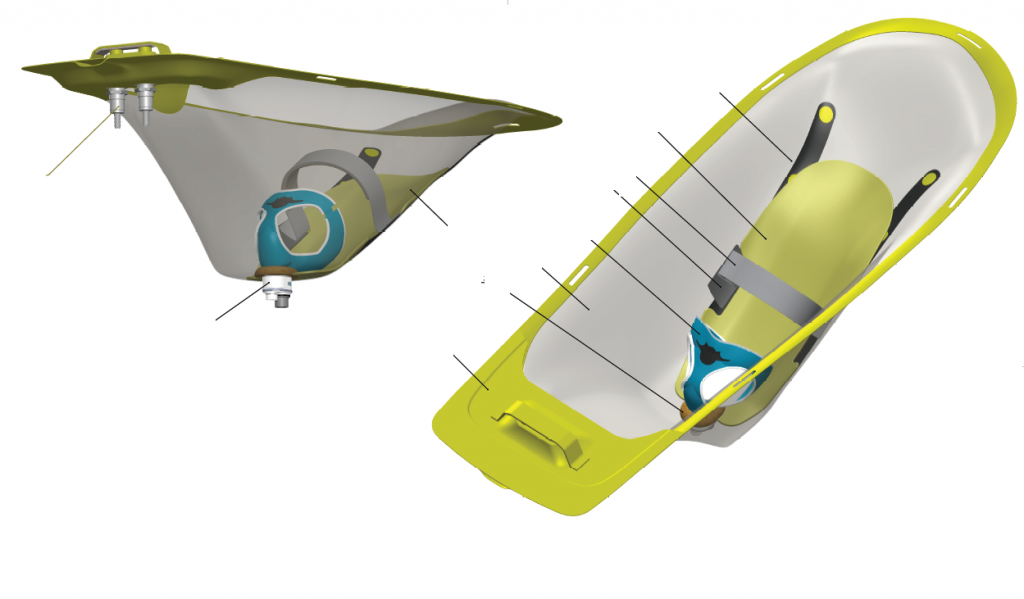
We look forward to answering any questions you may have. You can submit your questions on our contact us page.
Progress
Amnion Life’s R&D Facility Featuring Our Non-Sterile Clean Room in Serbia
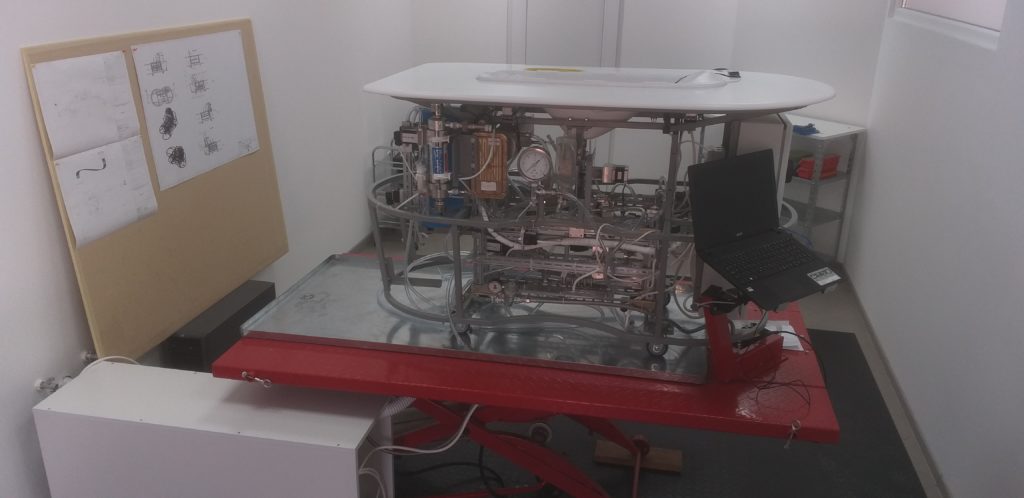
Patented
US Patent No. 15,342,988
US Patent No 10,166,161

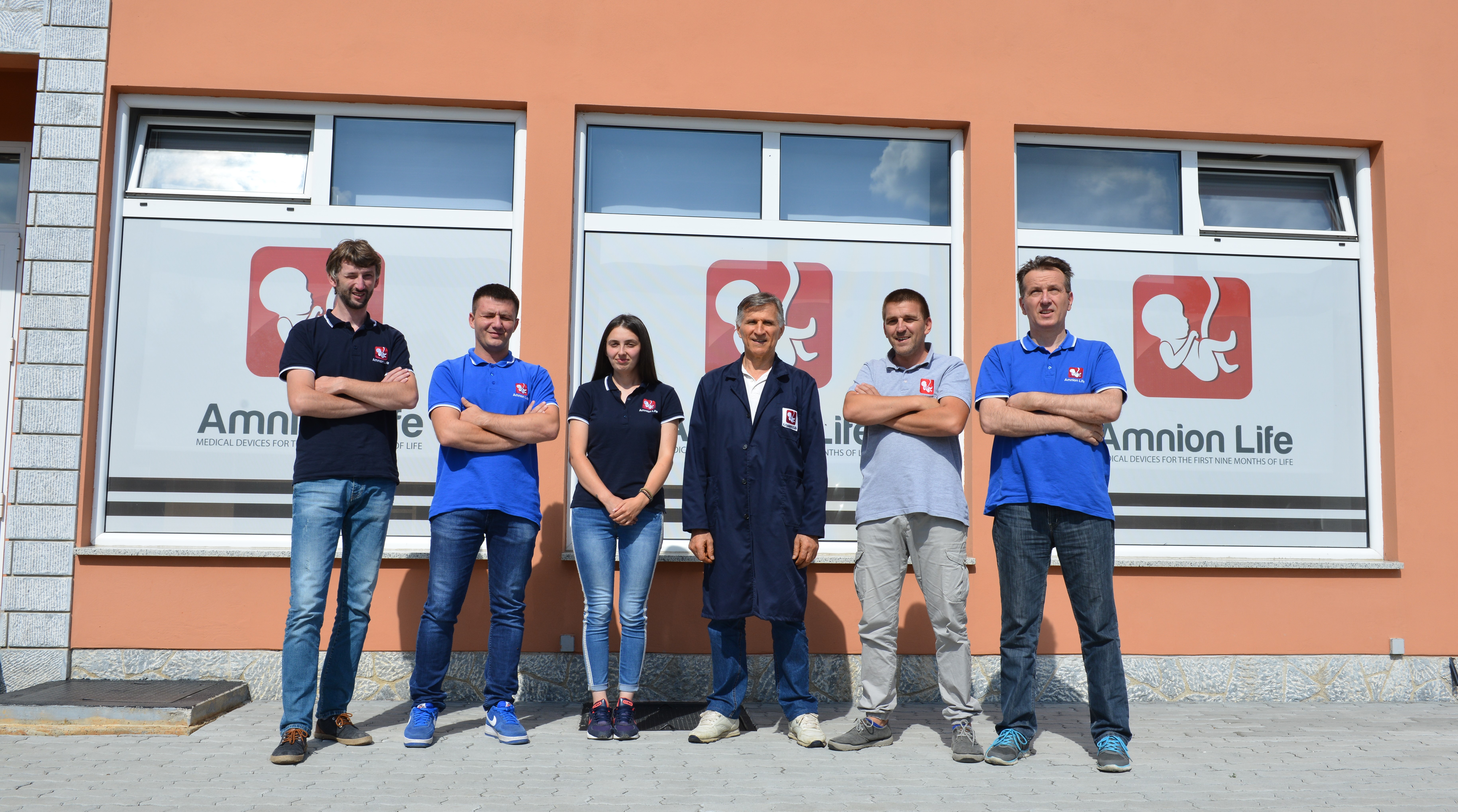
Completed Milestones
| Amnion Dream – Paris France | July 2013 |
| Completed Initial Medical and Scientific Review and Patent Search | December 2013 |
| Provisional Patent Application Filed | November 2015 |
| First Seed Round of Funding Secured | October 2016 |
| Feasibility study and R&D begin | October 2016 |
| Cleanroom R&D facility built in Pozega, Serbia – Amnion Life Pozega LLC Established | February 2017 |
| AmnioBed Patent Application Granted by USPTO – International Patent Application Through PCT Approved | April 2017 |
| Proof of Concept Design Completed | July 2017 |
| Parts and Material for Prototype Sourced and Procured | February 2018 |
| Second Seed Round of Funding Secured | May 2018 |
| Prototype Built and Prepared for Initial Testing | June 2018 |
| Quality Management System in Place | July 2018 |
| Initial Risk Analysis Completed | September 2018 |
| Comprehensive clinical review of device User Needs completed by Clinical Team | December 2018 |
| Initial Clinical Evaluation Report prepared | December 2018 |
| Artificial Placenta R&D Completed Patent application drafted and submitted | January 2019 |
| Second Patent on Amniobed obtained | February 2019 |
| Awarded 2nd place out of 100 competing companies at Stanford-UCSF Pediatric Device Consortium | March 2019 |
| Completed Reg CF Crowdfund Round [raised $305K from 186 investors] | April 2019 |
| Amniobed’s Patent Application granted and issued in China | January 2020 |

Press Releases
Company Updates
2019 Annual Report | Wefunder
The world is in desperate need of more sophisticated infant care. Despite ongoing technology advancements, current incubators and radiant warmers have many deficiencies that put preterm infants at risk for hypothermia. We believe our patented AmnioBed design can prevent hypothermia and save lives, reduce complications, improve short- and long-term outcomes, and decrease costs for millions of infants born preterm every year.
The Market
The Market (US Only)

Over $43 Billion is spent annually in the United States on costs associated with premature births.
This includes hospital costs, physician support, and other expenses.
- The US ranks 6th in the number of premature births when compared to other countries.
- The Centers for Disease Control and Prevention (CDC) estimated US premature births in 2016 at 388,130 per year.
- India ranks first among all counties with more than 3.5 Million premature births per year. Globally there are an estimated 15 Million premature births per year.
1/3 of those born are very or extreme preterm and ideally suited for AmnioBed.
The U.S. Market
648 NICU Facilities
19,600 Total Beds
Level iii and Level iV NiCUs
AmnioBed Market Segment (U.S. Only)
FAQs
Contact
Subscribe for Updates








